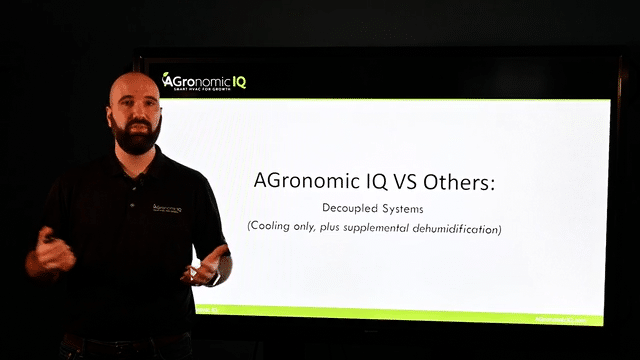
One of the other approaches that’s very common in this marketplace again, particularly early days, is decouple systems. So a cooling system that’s paired with a dehumidification system and potentially heating system as well to maintain the space conditions. This is how these spaces were maintained in the very early days and obviously black market transition to gray market transitional legalizing. This is how spaces were built. You put an air conditioner in place and you didn’t have enough dehumidification during particular parts of your growth, so you added a dehumidifier, and if you scaled up, you just added more of them.
That’s still an approach that’s very commonly used today for facilities. And let’s talk about it. So what I’m talking about again, a decoupled system, I’m talking about a cooling unit of some kind of packaged rooftop unit, a split system, a two pipe chilled water system.
There’s lots of different ways to achieve cooling, but a cooling system that doesn’t have enough dehumidification capacity. And then you pair it with dehumidification. So that cooling only system, typically you rely on it for partial dehumidification and then you supplement, like I said, and that separate dehumidifier is also what you’re using and lights off.
Obviously, when your lights are off, you don’t have a cooling demand, so you’re cooling system isn’t going to be running and thus not providing any dehumidification to you. It’s a very non integrated approach to handling these spaces. We’re typically seeing five to ten ton cooling units with relatively small dehumidifiers up to 25 pound an hour.
Dehumidifiers with sort of sort of be the upper limit of what a typical peak coupled system would look like. Which means you need a lot of them. A typical room might have a dozen air conditioners and 20 dehumidifiers, for instance.
And so that non integrated approach means that you’ve got a couple know there’s a couple of advantages, but there’s also some challenges that come with that. So one of the advantages is a very quick installation and shipping time.
Those units are not custom. They’re available off the shelf, and so they’re quick and easy to install and you’ve got a relatively low capital cost of equipment, certainly compared to some of the other options. And at least in past, this has been done with DIY or residential contractors, not necessarily the kind of contractor that you’d expect to see on a on a 50 zero ton building, for instance. And these are typically well-suited for small facilities, very small rooms, but not once the scale goes to commercial grow generally. Some of the challenges with decoupled systems actually the probably the biggest challenge is there’s no integration of controls between the cooling units and the dehumidification units.
In fact, usually your cooling unit is on its own thermostat. Your dehumidification unit is on a separate, humid asset and the two aren’t talking to each other, and they’re just doing their own thing with completely separate controls and no building automation integration between the two.
That obviously does some great things for redundancy, but it means that your room is never going to be accurately controlled. You’re going to have a typical residential grade thermostat that’s hopefully mounted in an intelligent place to accurately sense that part of the room.
But you probably have a dozen of them in your room, each controlling a separate air handler, which means that none of them are working together. You’re also going to have dehumidifiers again, same deal. The other challenge there is your dehumidifiers acting as a standalone dehumidifier puts all of that energy back into the room, so you’re paying to cool, you’re paying the dehumidifier and then you have to pay a third time to cool the dehumidification energy that got rejected back into your space, which means that these are more energy intensive. Then again, many people expect or understand and typically something like 30% more energy intensive than a unitary system with integrated dehumidification and heat rejection.
One of the counters to that is, well, you can get very high efficiency cooling systems and very high efficiency dehumidification systems, and that’s true. The irony of the high efficiency cooling units is they tend to have a higher, sensible heat ratio and do less dehumidification work, which means that you need additional dehumidifiers largely negating that gain.
And obviously, when you’ve got a ton of units in your space, you’ve got more points of failure, you’ve got more units to maintain fan belts, to change filters to change, more units to clean between growth cycles. If you were to end up with an infection in your space.
It’s going to be harder to root that out because you’ve got more nooks and crannies to clean in your room. All of that stuff means that it’s a false economy. Generally speaking, you’re not going to achieve particularly good room control, and it’s going to be expensive to maintain that space, and it’s going to be expensive to run that space in terms of energy costs and maintenance costs. It’s an option, it’s certainly a cheap option to get started. But generally, most growers who head in that direction are going to look at a more integrated approach for either their expansion phase or the next building they do.